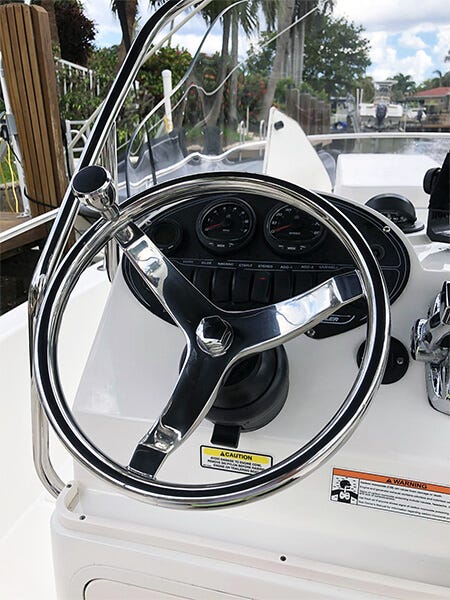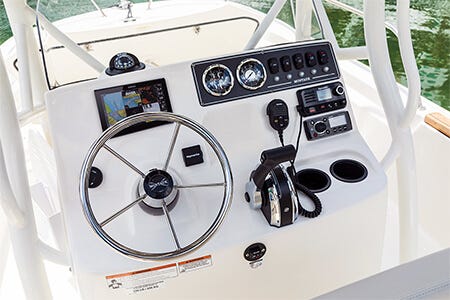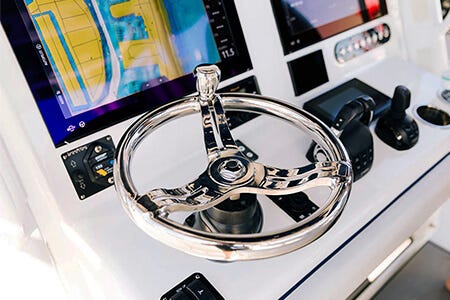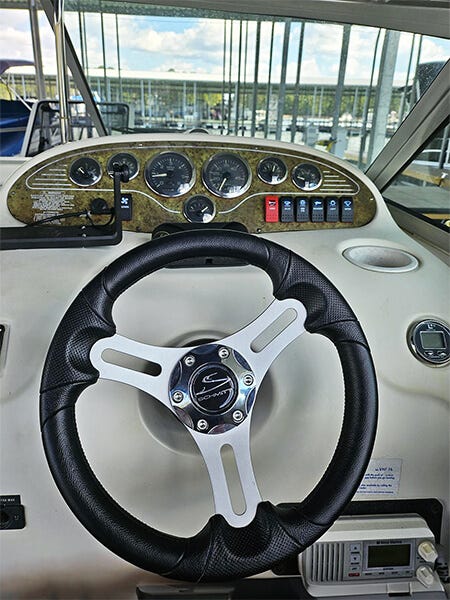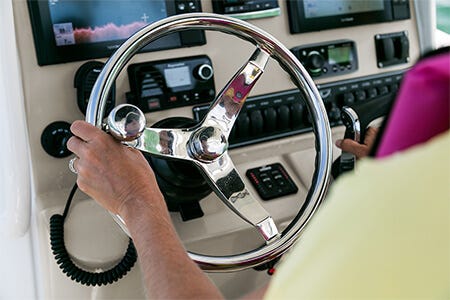Steer Smart: A Guide to Picking the Right Steering Wheel
February 16, 2024 10 min read


Your boat’s steering wheel may not be the first thing someone notices when they look at your boat from a distance or even step aboard. In fact, there are lots of other components that make a bigger visual impact. But in another way, your choice of steering wheel is incredibly important.
After all, you spend more time actually touching the steering wheel than anything else on board. So having a high-quality wheel that’s well-matched to your boat and boating style can make a much bigger difference than you might think in how you enjoy your boat. Here are a few important things to consider when choosing a new steering wheel for your boat.
Contents
- 1. What Size Boat Steering Wheel Do You Need?
- 2. Choosing a Boat Steering Wheel Style
- 2.1 Stainless Steel Three-Spoke
- 2.2 Five-Spoke “Destroyer”
- 2.3 Bluewater and Belloca
- 2.4 Polyurethane Three-Spoke
- 3. Getting the Right Size Shaft Nut for Your Steering Wheel
- 4. Do You Need an Assist Knob on Your Boat Wheel?
- 5. Why Boat Steering Wheels Cost So Much
- 6. Boat Steering Wheel Removal and Installation
- 6.1 Dealing With a Frozen Shaft Nut
- 6.2 Removing an Old Frozen Wheel
- 6.3 Installing the New Steering Wheel
What Size Boat Steering Wheel Do You Need?
The vast majority of recreational powerboats use one of two basic sizes of steering wheel: 13-1/2” or 15-1/2”. There’s some minor variation — some smaller wheels might be 13” instead of 13-1/2”, while some larger wheels might be 15” or 15-1/4”. But these two general sizes cover most applications.
So why choose one over the other? First, aesthetics is a factor. Obviously, a small wheel can look funny on a big boat and vice-versa. Most helm areas, though, are compatible with either size.
Second, smaller wheels are sort of like a “higher gear” for your steering; they’re faster to turn but require more steering effort, all else being equal.
You can spin a smaller wheel from lock to lock faster than a larger wheel, but the larger wheel is easier to turn.
In other words, you can spin a smaller wheel from lock to lock faster than a larger wheel, but the larger wheel is easier to turn. With modern hydraulic and power steering systems, the steering effort issue isn’t a significant factor, but with cable steering, a larger wheel can be noticeably easier to turn.
Third, helm space and clearance are important to consider. A smaller wheel frees up more real estate for drink holders, electronics displays, trim tab controls, switches, and other helm-mounted items that can’t be positioned “behind” the steering wheel.
Choosing a Boat Steering Wheel Style
Like steering wheel sizes, most aftermarket steering wheels for recreational powerboats fall into one of a few basic design categories: three-spoke stainless, five-spoke (aka “destroyer”), bluewater, belloca and three-spoke polyurethane.
Stainless Steel Three-Spoke Steering Wheels
First popularized by Edson and now made by several companies including Gemlux and Schmitt — are currently among the most popular with saltwater boaters.
Three-spoke stainless wheels are available in 13-1/2” and 15-1/2” sizes with or without an integrated assist knob.
Most are made from solid, cast Grade 316 stainless steel, although imported knock-offs may be a lesser grade of stainless.
Five-spoke destroyer-type wheels
Five-spoke destroyer-type wheels aren’t as much in style as three spoke wheels but were provided as original equipment on many saltwater boats. They are typically made of stamped Grade 304 stainless, making them less expensive than cast 316 stainless wheels. Some have molded foam-rubber grips on the rim, which provides a softer touch than bare stainless steel but does deteriorate over time.
Bluewater and belloca wheels
These are made by Gemlux, but other manufacturers produce similar styles under different names. Both are premium steering wheels and significantly more costly when even three-spoke wheels from the same manufacturer. The bluewater-style wheel is essentially a stylized “two-spoke” that is often installed as original equipment on Yellowfin boats and other large center consoles. The belloca wheel is a three-spoke design with added detail for a striking, high-end aesthetic.
Three-spoke polyurethane steering wheels
These are typically found on freshwater-oriented boats like wake and ski boats, bass boats and pontoon boats. They are normally made with aluminum spokes and a polyurethane rim and often feature styling reminiscent of car steering wheels — vinyl-wrapped rims, contoured plastic covering the spokes, etc. Like rubber-coated destroyer wheels, polyurethane boat steering wheels tend to look sharp and feel good in your hands but won’t stand up to sun, moisture and salt like stainless steel will. Over time, they tend to fade, crack or tear, especially if stored uncovered.
Getting the Right Size Shaft Nut for Your Steering Wheel
Fortunately, boat steering wheels are fairly universal in terms of fit. The vast majority of boat helms (the steering mechanism the wheel connects to) use a tapered 3/4” shaft that the wheel slips onto. A small, half moon-shaped piece of metal called a Woodruff key fits into notches on the shaft and the wheel to keep the wheel from spinning freely.
The vast majority of boat helms use a tapered 3/4” shaft that the wheel slips onto.
With the exception of stainless steel three-spoke steering wheels, most wheels use a locking nut to hold the wheel on the shaft. If possible, the old shaft nut can be reused with the new wheel. The nut is tightened with a socket wrench; then a decorative plastic or stainless steel cap is snapped on to cover the shaft and nut. Bluewater wheels also use a regular locking nut but also have a unique collar system to keep the wheel in place.
With the exception of stainless steel three-spoke steering wheels, most wheels use a locking nut to hold the wheel on the shaft.
Three-spoke stainless steel wheels use a decorative nut on the shaft instead of a regular locking nut. This nut is the only thing that’s not fairly universal. The right size steering wheel nut depends on your helm. Most mechanical, e.g., cable, helms use 1/2” (0.5”) nut. Most hydraulic and power steering systems use a 5/8” (0.625”) nut. Verado systems, finally, use a 12mm nut.
Do You Need an Assist Knob on Your Boat Wheel?
Assist knobs (also commonly called “suicide knobs” and “power knobs”) make it easier to turn your boat’s steering wheel quickly. Some steering wheels come with an integrated assist knob, or a clamp-on knob can be added to an existing wheel. The positive is obvious: in docking and other tight-quarters situations, the ability to quickly and smoothly spin the wheel can be very helpful.
Assist knobs make it easier to turn your boat’s steering wheel quickly.
But what about the downsides to assist knobs? First, for novice boaters, the ability to spin the wheel rapidly isn’t always a good thing. Second, in some applications, assist knobs can create clearance problems. Specifically on boats that are designed to be driven standing up with wheels that are mounted vertically or close to vertically, an assist knob can sometimes hit you in the thighs or “below the belt” when running rough seas.
Make sure there’s enough room between your leaning post and steering wheel that the knob is unlikely to hit you when it’s positioned near the bottom of the wheel. Third, assist knobs are most helpful on boats with fairly “open” helm areas. On many bass boats, runabouts and ski/wake boats, where the driver sits low to the floor and close to the dash and the starboard side of the boat, there isn’t enough arm room for an assist knob to be very helpful.
Why Boat Steering Wheels Cost So Much
Boaters are often shocked at the price tags on aftermarket boat steering wheels, which can top $1,000 for high-end carbon fiber wheels and regularly exceed $200 for quality stainless wheels. The reasons are fairly simple: top-quality, Grade 316 stainless steel is expensive, and — just like a cast stainless propeller — a cast steering wheel uses a lot of it.
Wheels that contain more stainless — like the bluewater and belloca styles, for example — cost more to make. Likewise, producing a consistent, beautifully finished product requires advanced processes and quality control. Remember, though, that a good quality stainless steel boat wheel from an established company like Gemlux, Edson or Schmitt will outlast your boat — and quite possibly you.
Remember that a good quality stainless steel boat wheel from an established company will outlast your boat.
Of course, destroyer-style wheels, which are typically made from stamped Grade 304 stainless — as opposed to cast 316 stainless — are significantly less expensive, while aluminum-and-polyurethane wheels like those found on many freshwater-oriented boats, are more affordable still.
Ultimately, it comes down to questions of aesthetic preference and longevity. In just the way that a $30 Timex tells the same time as a $7,000 Rolex, a $40 plastic wheel will turn your boat just the same as a $400 stainless wheel. It’s just that the stainless wheel will look and feel better when doing it and last many times longer.
Boat Steering Wheel Removal and Installation
Usually the hardest part of installing a new steering wheel on your boat is removing the old one. The first challenge in removing the shaft nut, which can sometimes be frozen on.
Dealing With a Frozen Shaft Nut
If you encounter a frozen nut, do not use your steering system as resistance to try and turn it. In other words, don’t turn the wheel all the way to port and exert pressure on the nut. This can damage your steering system. Instead, have a helper hold the wheel tightly as you turn the nut. If you don’t have a helper, you can sometimes use a piece of two-by-four wood or something similar through the wheel to hold it in place while you try to turn the nut.
If you encounter a frozen nut, do not use your steering system as resistance to try and turn it.
If you still can’t budge the nut, try soaking it with a penetrating oil like PB Blaster and letting it sit for an hour or even overnight and then try again. Sometimes applying heat to the night can also help. Be patient; it’s important not to damage the threads on the helm shaft.
Removing an Old Frozen Wheel
Even with the nut removed, the old wheel will often be frozen onto the tapered shaft. This is frustrating, since there’s nothing really holding the wheel in place. It’s supposed to slide right off the shaft. If it doesn’t, resist the urge to try to knock it loose by hitting it from behind with a mallet or other tool. This can bend the helm shaft or otherwise damage the helm.
Instead, start by applying penetrating oil around the shaft. If that doesn’t do it, try using a punch or similar tool and a hammer to tap on the Woodruff key. Don’t hit it hard enough to deform the key; just tap it from various directions to try and get it to move. Often if you can get the key to budge a bit, the wheel will come off too.
Often if you can get the key to budge a bit, the wheel will come off too.
If that doesn’t work, an automotive gear puller usually does the trick. Gear pullers are readily available and inexpensive both online and in auto parts stores. Many chain auto parts stores will even loan you a gear puller through a loaner tool program.
Another frequently recommended method involves hitting the shaft nut with a hammer. To do this, thread the nut back onto the shaft a couple of turns so that the end of the shaft does not protrude above the nut. This is to protect the shaft from damage. Then, while pulling on the wheel by hand, strike the nut with a hammer. Although this often does work, there’s a risk of damaging the threads on the shaft, so using a gear puller is the preferred method.
Installing the New Steering Wheel
With the old steering wheel off, installation of the new wheel on your boat is a simple job. Wipe the helm shaft clean and then apply a light coat of synthetic grease or Tef-Gel to the shaft. This prevents — or at least delays — the new wheel freezing onto the shaft. Then position the Woodruff key and slip the wheel onto the shaft. Finally, tighten the shaft nut enough that there’s no play in the wheel and then roughly a quarter-turn more. Don’t overtighten.

